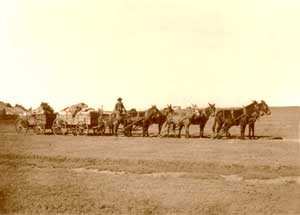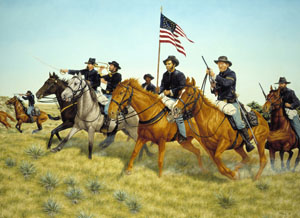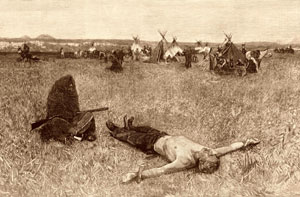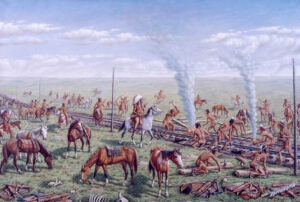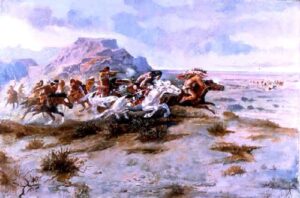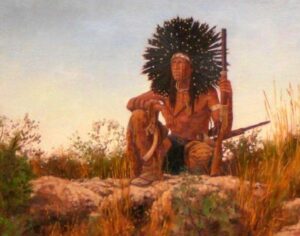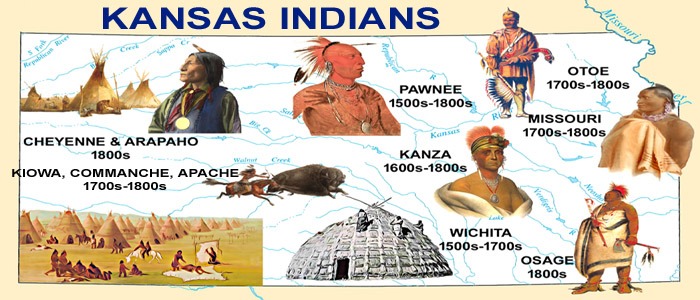
Kansas Indians
Despite the Government’s efforts to force the Indians of Kansas onto reservations, the natives did not abandon the Saline Valley peaceably.
The 1860s brought ever-growing numbers of travelers and settlers into Indian lands in Kansas. Taking advantage of tribal divisions, the U.S. government negotiated treaties that forced the Plains Indians onto reservations and limited their hunting areas. Though relations between travelers and settlers and the Indians were generally peaceful, tensions developed, and periodic violence occurred. A fragile peace was shattered in the 1860s when Indians took action to defend their lands, and the U.S. military responded.
Though dangers were braved throughout the area, none of the surrounding counties lost so many from Indian depredations as Lincoln County in the 1860s.
On August 6, 1864, four buffalo hunters named John W. Houston and James Tyler and two brothers named John L. Moffitt and Thomas Moffitt were surprised in camp near Rocky Hill and were killed by Cheyenne Indians.
On about August 8, 1864, John Cline, a freighter and buffalo hunter, met Mrs. John Houston and her three children, who her brother in Salina, Kansas, accompanied. She informed Cline that her husband and some other men had gone on a buffalo hunt and that shortly after they left, she heard firing and saw about 150 Indians approach their home. They peered into the house and remained there for some time. The only weapon they had in the house was a short musket. The woman persuaded her brother to load the gun, and when the Indians were at the barn a short distance from the house, her brother fired at one of them, and the Indian fell. The Indians then scattered.
Cline and several others then organized a company of 13 men and started for the scene. After camping the first night east of Tescott in Ottawa County, they reached Beaver Creek the next morning. The men then began to look for the missing buffalo hunters. They followed wagon tracks toward the creek when one of the men stood and waved his hat. There they found the four men lying between two ledges of rock.
The wagon and team were south of them on a little rise of ground. The wagon was partly burned, the horses shot in the head, and the harnesses cut to pieces. The scalps of Houston and Tyler were lying on a rock. John Moffit was shot full of arrows. The search party then wrapped the victims in blankets and buried them a few yards east of where they fell. The search members described that the men appeared to have fought desperately and must have killed several Indians. Tracks showed that the Indians had retreated west up the Saline River.
Afterward, the bodies of the Moffitt brothers were exhumed and returned to their home cemetery in Illinois.
During this time, the troops on the frontier were very poorly armed, as the main forces were fighting in the Civil War.
We “furnished such arms as were at hand to Captain Booth stationed at this post. Those arms are of various kinds, cavalry and infantry, and are unfit to issue to either except in case of emergency.”
— Captain O.F. Dunlap, 15th Kansas Cavalry, commanding Fort Riley, May 1864
Henry Booth was captain of Company L. Eleventh Kansas Cavalry, which was raised in the neighborhood of Fort Riley. In the summer of 1864, he commanded a battalion on duty in the neighborhood of Saline and Lincoln Counties.
In a report of a scouting trip along the Smoky Hill and Arkansas Rivers in the first days of August 1864, dated the 5th, at Salina, Captain Booth mentioned finding a recent campsite of from 400-500 Indians having a lot of stock, on Big Creek, probably in what is now the southeast corner of Ellis County. He concluded:
“I think from present indications the Indians are upon the Saline, Solomon, and Republican Rivers, as the buffaloes are plenty upon these streams, and they depend entirely upon them for a living. Undoubtedly they are encamped upon one of these streams.”
Treaties in 1865 and 1867 temporarily eased concerns. Pressures mounted again as railroad construction moved further onto the plains. In 1868 Northern Cheyenne leader Roman Nose led a retaliatory strike against settlers along the Solomon River. Other strikes, led by the Cheyenne Dog Soldiers, occurred along the Saline River and tributaries in Lincoln County and nearby counties.
In June 1868, a party of Cheyenne “Dog Soldiers,” unauthorized bands of renegade Indians, raided Spillman Creek and captured Mrs. David Bacon, Mrs. Shaw, and her sister, Miss Foster. After subjecting them to brutal treatment, they tied their hands and feet and staked them out on the prairie. They were found nearly two days later by their friends and lived to tell the tale.
In August 1868, Martin Hendrickson found two little girls, aged six and nine years, at the mouth of Spillman Creek. The Indians had captured the girls, and, worn out from hanging on the bare backs of the Indian ponies; they were dropped on the edge of the bluffs northwest of Lincoln. The girls had been nearly several days without food. Their father, Aaron Bell, had been captured near Beloit, Kansas. Mr. Hendrickson felt an uncontrollable impulse to go up the river six miles, and, although urged to remain at home by his family, he went. Mr. Hendrickson thought an all-wise Providence ordered him to go for the particular purpose of saving the little ones.
On May 28, 1869, a group of Indians tore up the track and ditched the train on the railroad, and had a battle with the railroad gang that built the road. Two white men were killed, and four were wounded. The wounded were taken to the government hospital at Fort Harker.
On Sunday, May 30, 1869, the Spillman Creek Raid occurred when Tall Bull’s band of about 60 Cheyenne Dog Soldiers came down Spillman Creek in the early afternoon. They divided into bands of from five to seven braves and then made simultaneous attacks at different locations.
Their first victim was John H. Strange, a son of Reverend John S. Strange, one of the earliest settlers in Elkhorn Township. John Harrison Strange and a German boy named Arthur Schmutz, who was about 14 years old, were hunting in the breaks of Spillman Creek when the Indians came upon them. Professing to be good Pawnee, they managed to get close enough to shoot Strange with an arrow and crush his skull with a war club, which was later found beside his body, broken in two. Two of John’s brothers, aged twelve and nine, started to the rescue, the older carrying the gun and the younger the ammunition.
Schmutz ran for his life but was shot with an arrow. When he was found, the arrow shaft was extracted all except part of the arrowhead, and the boy was taken to Fort Harker and placed in the government hospital. He lived and suffered for ten weeks before death relieved him. He was buried at Fort Harker.
Later that day, Thomas Alderdice was returning from a trip to Junction City with several other men. When he was about three miles from his home, he heard that a band of Indians had been into the settlement, murdered many people, and destroyed considerable property. Alderdice had been one of Colonel George A. Forsyth’s scouts and fought with him in the Battle of Beecher Island in eastern Colorado in September 1868. On arriving at his home, he found it deserted. At first, he was probably not alarmed because he had asked a neighbor, Nicholas Whalen, to care for the women and children.
That day, Susanna Alderdice, who was pregnant, had gone with her children to visit Mrs. Timothy Kine, and together, they were making their way to Whalen’s house. It was getting close to evening when Indians overtook them. Mrs. Kine, with her tiny baby, escaped to the river, and the Indians failed to find her. She then managed to make her way to the farm of Ferdinand Erhardt during the night or early the next morning. She and her baby both survived. However, she later became a “mental wreck” and spent time in an asylum.
However, Susanna Alderdice and her children were not so lucky. Thomas Alderdice, looking for his family, was almost paralyzed with grief when he found his five-year-old stepson, John Daily, dead on the ground, with four bullets in his body, and his two-year-old son Frank Alderdice was shot with five arrows. They had been killed on the Whalen farm. Another stepson, four-year-old Willis Daily, was missing, but the next day, Thomas found the boy after hearing his moans. He had been shot in the back with an arrow and was left for dead. Phillip Lautz and Washington Smith, by the aid of a pair of cobbler’s pinchers, pulled out the arrow and saved the boy’s life. He was then taken to his grandfather Michael Zigler’s home, and amazingly, he recovered and survived. Susanna’s parents raised him.
Thomas’ wife, Susannah Zigler Daily Alderdice, and eight-month-old infant daughter, Alice, were taken captive.
At about the same time, Mr. and Mrs. George Weichell and Mr. Meigerhoff were at their home about two miles from the Alderdice house. When they saw the Indians coming, heard the shooting, and their war whoops, they ran down the creek to the Saline River. They were certainly trying to get down to the Schermerhorn Ranch. But the Indians discovered them in their flight and started in pursuit. Though both men had good firearms and it was a running fight all the way, the ammunition gave out, so they were easy prey for the Indians. They were overtaken in Indiana Township, about 1.5 miles west of Lincoln Center. The two men were then killed, and Maria Weichell was taken prisoner about a quarter of a mile from where Mrs. Alderdice was taken prisoner and her children killed.
The Dog Soldiers also made other depredations. A Danish man and wife, who were seeking land, were murdered on Spillman Creek, about four miles west of Lincoln. The woman initially escaped, but when the Indians attempted to recapture her, she was struck in the head with a tomahawk. A silversmith originally from Chicago, Illinois, named Peterson had his head smashed with his own ax and was shot through the heart with an arrow. The Indians also tried to burn his house but were frustrated in all their attempts to destroy it. The house of Thomas Alderdice was also attacked, but the assailants were driven off by three Swedes who wounded two of the Indians. The house of William Hendrickson was saved by the heroism of two women – Mrs. Hendrickson and Mrs. Green, who fired on the Indians several times and finally drove them away.
When the raid was over, the Indians left the next day without hindrance from the soldiers. After crossing the Saline River, they went about due south to Bullfoot Creek, where they camped on the Opplinger farm at a stone cave. Three days after the raid, Susanna’s baby cried a lot, and the annoyed Indians wrung its head and threw her into a stream.
The Indians and their captives then reached the south fork of the Platte River in Colorado, between Julesburg and Sterling. Here Susanna Alderdice and Maria Weichell remained in captivity for 42 days by Tall Bull, the chief of the Dog Soldiers, until July 11, 1869. On that day, Major Eugene Carr’s 5th Cavalry, Buffalo Bill Cody, and Pawnee Indians attacked Tall Bull’s village at Summit Springs, Colorado. During the battle, Captain Cushing found the two white women in Tall Bull’s tent. Susanna was fatally struck with a tomahawk to the face at the beginning of the fight and was breathing her last as the soldiers entered the tepee. Maria Weichell was gravely wounded by a bullet in the back but could sit up. The Indians meant to have killed both of the women but were taken by such a sudden surprise that they did not have time to complete the dastardly deed. Susanna Alderdice was buried in the middle of the captured village, but her burial spot is unknown. Mrs. Weichell was taken care of and lived to tell the tale of their hardships during their captivity.
The Battle of Summit Springs broke the power of the Cheyenne Dog Soldiers on the Central Plains.
©Kathy Alexander/Legends of Kansas, updated July 2023.
Also See:
Battle of Summit Springs, Colorado
Sources:
Bernhardt, C.; Indian Raids in Lincoln County Kansas, The Lincoln Sentinel, 1910
Indian Raid Affidavits
Michno, Gregory, and Susan; A Fate Worse Than Death – Indian Captivities in the West, 1830-1885; Caxton Press, 2007.
Garfield, Marvin H.; Defense of the Kansas Frontier 1868-1869, Kansas Historic Quarterly, November 1932
Find a Grave – Susanna Alderdice
Lincoln County Historical Marker
Leavenworth, Kansas Times & Conservative, June 20, 1869

